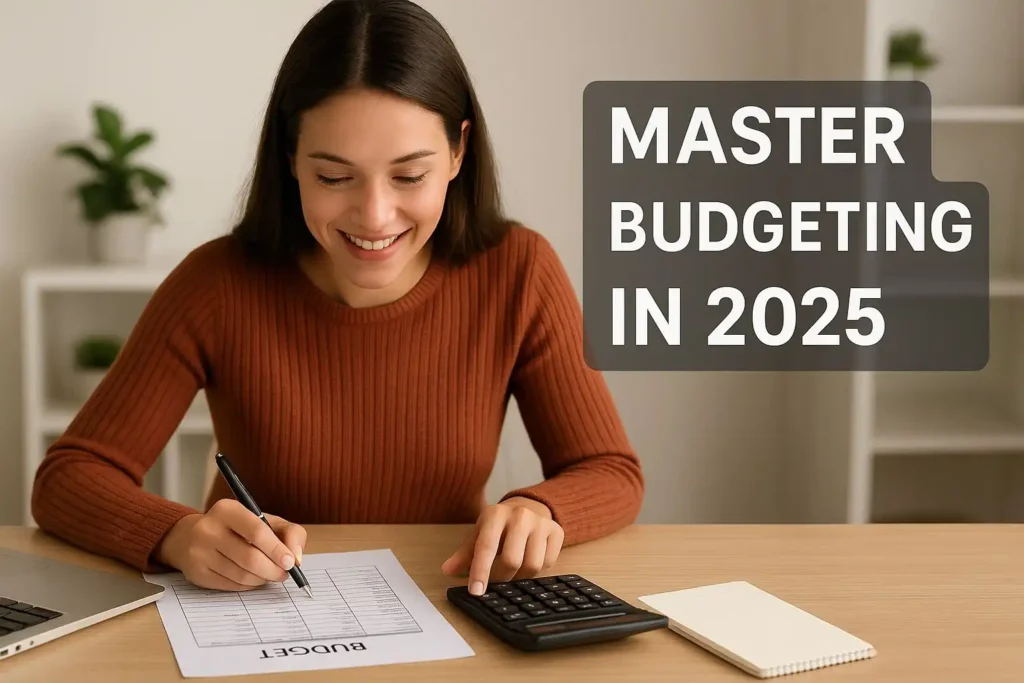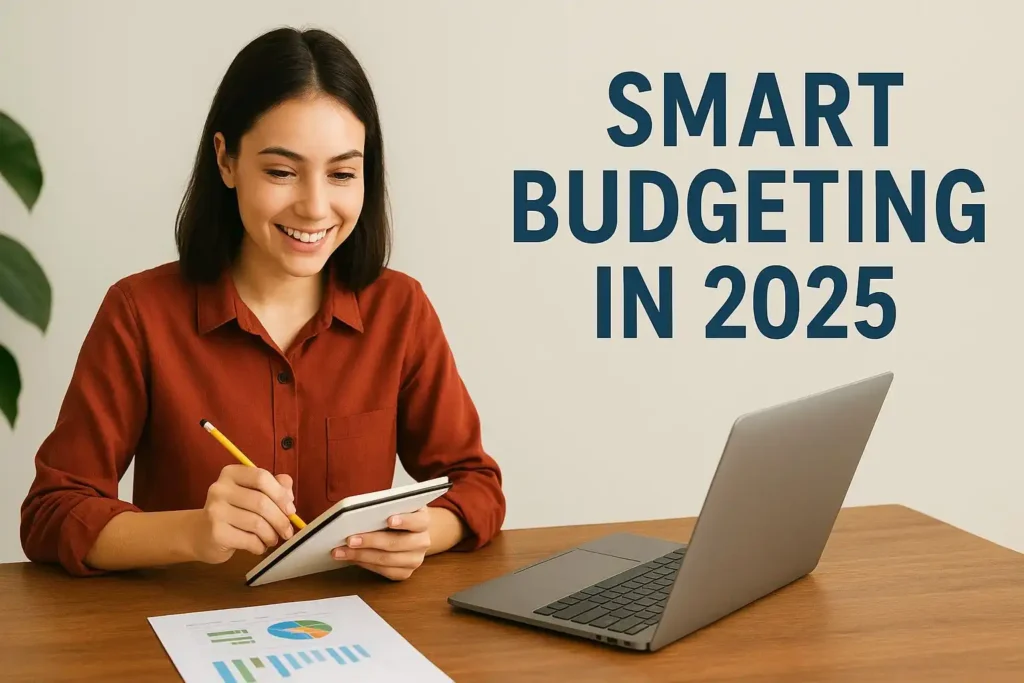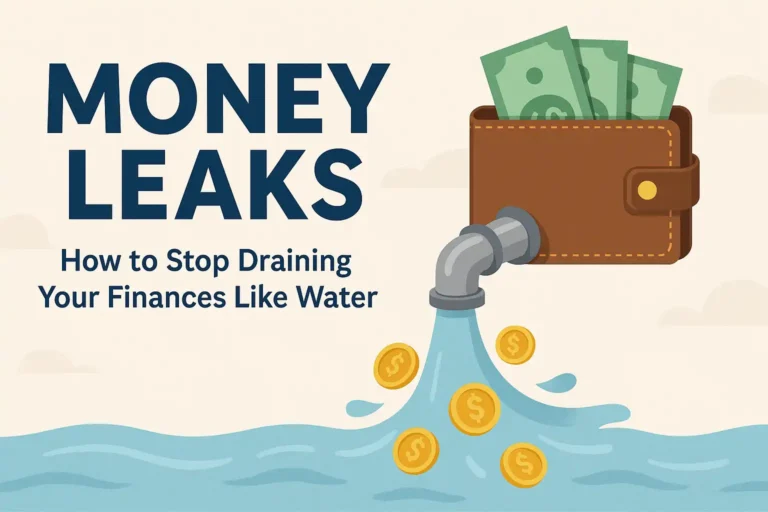Originally Published: March 2025 | Last Updated: August 2025
Unlock modern strategies, tools, and tips to build wealth in the new economy
Ever feel like your salary disappears before the month ends? You’re not alone. In 2025, with rising living costs and endless subscriptions, mastering budgeting is no longer optional—it’s survival. A solid budget doesn’t just track your money; it helps you take control, reduce stress, and move closer to financial freedom. Whether you use a modern budget planner, an AI-powered expense tracker, or just a simple spreadsheet, the principles remain the same: spend wisely, save consistently, and invest smartly. This guide will show you how to avoid common mistakes, answer burning money questions, and uncover the best way to save money today.

Why Budgeting is Different for FY 2025
The post-pandemic economy, AI advancements, and climate-conscious consumerism have reshaped how we manage money. Key trends influencing this year budgets include:
AI-Powered Financial Tools: Apps now predict spending habits and automate savings with precision.
Hybrid Work Models: Remote work reduces commuting costs but increases home-related expenses.
Inflation and Economic Volatility: Adaptive budgeting is critical to withstand price fluctuations.
Sustainability-Driven Spending: Consumers prioritize eco-friendly purchases, impacting budget allocations.
To thrive, your budget must be dynamic, tech-savvy, and goal-oriented. In this environment, a smart, adaptable budgeting plan can be the difference between financial stress and a secure, wealth-building future.
The Best Budgeting Methods (Types of Budgets)
While there is not a one-size-fits-all solution, several popular budgeting strategies have proven effective:
1. The 50/30/20 Rule
A perennial favorite, the 50/30/20 rule divides your after-tax income into three clear categories:
• 50% for Needs: Essential expenses such as housing, utilities, and groceries.
• 30% for Wants: Discretionary spending on dining out, entertainment, and hobbies.
• 20% for Savings and Debt Repayment: Building an emergency fund, saving for retirement, or paying down high-interest debt.
This method is praised for its simplicity and balance, making it a great starting point for many.
2. Zero-Based Budgeting (ZBB) 2.0
Zero-based budgeting assigns every dollar a job, ensuring your income minus expenses equals zero. By planning each dollar’s purpose—whether for bills, savings, or investments—you leave no room for unplanned spending. This method can be particularly effective if you’re looking to eliminate wasteful expenses and gain granular control over your finances.
3. Pay Yourself First
In the Pay Yourself First approach, you automatically transfer a predetermined portion of your income into savings or investment accounts before you pay any bills. This method reduces the temptation to spend what is left over and prioritizes long-term wealth-building over immediate gratification.
Automating your savings is key to this strategy, as it leverages technology to make saving effortless.
4. The Envelope System (Digital Version)
Traditionally, the envelope system involves dividing cash into envelopes for each spending category. Today, digital apps mimic this approach by allocating your budget into “virtual envelopes.” This tactile method can help curb impulse spending and ensure you do not overspend in any category.

How to Create Your Budget: A Step-by-Step Guide
Step 1: Calculate Your Income
Begin by tallying all sources of income:
• Primary Income: Salary, wages, or business income.
• Secondary Income: Freelance work, dividends, interest, or any side hustles.
Understanding your total monthly income is crucial, as it forms the foundation of your budgeting plan.
Step 2: Track Your Expenses
Identify every expense for at least one month:
• Fixed Expenses: Rent/mortgage, insurance, loan repayments, and utilities.
• Variable Expenses: Groceries, dining out, transportation, and discretionary spending.
• Irregular Expenses: Annual subscriptions, medical bills, or holiday spending.
Tracking your spending using budgeting apps like YNAB or EveryDollar can provide insights into your spending habits.
Step 3: Set Clear Financial Goals
Define what financial freedom means to you. Whether it is buying a home, retiring early, or clearing debt, set both short-term and long-term goals. Use SMART criteria (Specific, Measurable, Achievable, Relevant, Time-bound) to give your goals structure and clarity.
For example, “I will save $5,000 for an emergency fund by December this year” is a goal that motivates and guides your budgeting decisions.
Step 4: Choose Your Budgeting Method
Select the method that best aligns with your financial personality:
• If you appreciate a structured, percentage-based approach, try the 50/30/20 rule.
• For meticulous control over every dollar, zero-based budgeting might be ideal.
• If you struggle with saving, Pay-Yourself-First ensures that a portion of your income is always dedicated to wealth-building.
Step 5: Monitor, Adjust, and Automate
Your budget should be dynamic. Regularly review your expenses, compare them with your set goals, and adjust your budget as necessary. Automate bill payments and savings transfers to reduce the mental load and minimize human error. Periodic check-ins (monthly or quarterly) can help you stay on track and pivot if your financial situation changes.
Techniques for Busting Bad Financial Habits
Even the best budgeting plan can be derailed by poor financial habits. Here are some actionable techniques to break free from detrimental spending patterns:
Cut Unnecessary Subscriptions
Subscriptions to streaming services, gym memberships, and apps can quietly drain your budget. Regularly audit these services and cancel any you are not using. Using apps like Trim can help identify these recurring charges for you.
Curb Impulse Buying
Impulse spending can quickly derail your budgeting efforts. Try implementing the 24-hour rule: wait a day before making a non-essential purchase. This pause helps you determine if the purchase is truly necessary.
Eliminate Lifestyle Inflation
As your income increases, it is tempting to upgrade your lifestyle immediately. Instead, increase your savings and investments first. This discipline ensures that you are building wealth rather than simply spending more.
Track and Reflect on Your Spending
Awareness is key to change. Use budgeting apps to track your daily spending, and at the end of each week, review your expenditures. Reflect on any impulse buys or non-essential expenses and consider how they impact your overall financial goals.
Engage in Savings Challenges
Challenges such as the “52 Week Savings Challenge” or the “100 Envelope Challenge” gamify the process of saving money. These challenges can be particularly effective for those who need a fun, engaging way to remain disciplined with their finances.
Top 5 Budgeting Mistakes to Avoid
Even the most motivated people slip up while budgeting. Here are the top mistakes to watch out for:
1. Ignoring Small Expenses
That daily coffee or extra streaming subscription looks harmless but can derail your budget. Use an expense tracker to see the truth—those little amounts pile up quickly.
2. Not Having an Emergency Fund
Many skip saving for unexpected events. Without a backup fund, one car repair or medical bill can wipe out months of progress.
3. Being Unrealistic with Numbers
Some people set strict, impractical limits that are impossible to maintain. The goal of budgeting isn’t perfection—it’s sustainability.
4. Forgetting Annual or Irregular Expenses
Insurance premiums, school fees, or holiday shopping often catch people off guard. A good budget planner includes these from the start.
5. Not Reviewing and Adjusting
A budget isn’t static. Income and expenses change, and your plan should too. Review monthly and tweak accordingly.
👉 Avoiding these mistakes ensures your budgeting efforts are actually moving you closer to your goals—and not leaving you frustrated.

Tips and Tricks to Achieve Financial Freedom
1.Build a Robust Emergency Fund: Set aside at least three to six months’ worth of living expenses.
2. Pay Down High-Interest Debt: Especially high-interest credit card debt..
3. Invest Consistently: Investing with Automation is a powerful tool for growing your wealth.
4. Educate Yourself Continuously: Financial literacy is the cornerstone of good money management. learning about personal finance, investment strategies, and economic trends.
5. Leverage Technology: Budgeting apps track your spending but also provide data-driven insights.
6. Keep a “Why” at the Forefront: Finally, always remember WHY you are budgeting in the first place. Whether your goal is to buy a home, retire early, or simply reduce financial stress. Writing down your “why” and placing it in visible locations—like on your bathroom mirror or workspace.
FAQs: Smart Answers to Common Budgeting Questions
Q1. What’s the easiest way to start budgeting in 2025?
Start small. Pick one budget planner or app that suits your lifestyle. Track your income and expenses for a month. Then, use the 50/30/20 rule: 50% needs, 30% wants, 20% savings/investing. This is considered one of the best ways to save money without overwhelming yourself.
Q2. Do I really need an expense tracker if I already use my bank statements?
Yes. Bank statements show transactions, but an expense tracker categorizes them in real time. This helps you see patterns—like overspending on food delivery—and make actionable changes.
Q3. How much should I save each month?
Aiming for at least 20% of your income is a solid start. However, if your goal is financial freedom earlier, push for 30–40%. The key is consistent budgeting and investing in growth-oriented assets.
Q4. Is budgeting still relevant with inflation and rising costs?
More than ever! Inflation makes money lose value over time. Smart budgeting helps you cut unnecessary spending and channel funds into inflation-beating investments. It’s not about restriction—it’s about empowerment.
Q5. What’s the best way to save money if my income is low?
Prioritize essentials and cut lifestyle creep. Automate savings, even if it’s just $50/month. Combine this with side hustles or skills that increase income. Remember, budgeting is about progress, not perfection.
Q6. Which budgeting style works best in 2025?
There’s no “one-size-fits-all.” Some thrive with zero-based budgeting, others with the envelope system. Tech-savvy people benefit from apps with built-in budget planners and AI-powered expense trackers. Experiment and stick with what works.
Q7. Can budgeting really help me achieve financial freedom?
Absolutely. Financial freedom isn’t about how much you earn but how well you manage it. Through consistent budgeting, avoiding debt traps, investing wisely, and finding the best way to save money, financial independence becomes achievable.
Final Thoughts:
Breaking bad financial habits, prioritizing savings and investments, and continuously educating yourself are key components of a successful financial strategy. Remember, every dollar you save and every debt you eliminate is a step closer to the freedom to live life on your terms.
As you embark on this journey, know that consistency is more important than perfection. you can turn financial planning into a pathway to freedom.
Start small, stay consistent, and let technology simplify the journey.
if you want to earn high with very less expense then visit our popular post > Geoarbitrage: How to Live Rich by Earning in Dollars and Spending in Pesos







